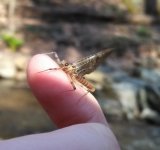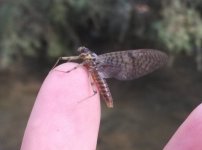Of the ones you mentioned, well, tricos are easy.
The rest:
BWO: At least a dozen different varieties that most experts can't tell apart. Most of us settle for Baetis or Drunella. i.e. 2 different families.
Sulpher: 2 "main" types of sulpher, which are frequently distinguished based on slight size and color differences. There are 4 or 5 other bugs which some people call sulphers, though, but they are not the "core" sulpher hatch or are generally known by other names to most.
Midges: There's a whole bunch of them and I don't even try! Knowing that it's a midge and adding size and color is as far as I go. You could probably learn more specifics like we do with mayflies, and it might help sometimes, but it would be real tough to identify them.
Caddis: I'm deficient here too. I mean, I know it's a caddis, and know the MAJOR hatches of various varieties. But when you see the random one fluttering around I've just got no clue. Species is probably more important in the pupa stage as they build different kinds of casings in the water.
Stones: Again, they all act similarly, just look way different. So I know little black, big golden, etc. Of goldens, though, I have played a little with trying to identify species based on the patterning. Not sure it does a whole lot.
Generally with mayflies knowing the differences mean more. For instance, in sulphers, the 2 main ones are ephemerella dorothea and invaria, which are closely related and act similarly. Many can still tell them apart from one another but it often doesn't matter. But Epeorus Vitreus (AKA Pink Lady) is called a sulpher by many and in a totally different family. They do look similar to invaria. But the differences ARE important.
For instance,
1. Ephemerella species typically emerge from slowish water. Epeorus from fast water.
2. Ephemerella swim to the surface as nymphs, transform slowly in the film, and float a while before flying. i.e. emergers and dries are much more important, and floating a nymph in the film can be ridiculously successful. Epeorus transforms on the bottom and "flies" to the surface as an adult, and gets through the film and takes flight quickly. i.e. wet flies take more priority during a hatch.
That's a pretty big difference. If you see a hatch is beginning, catch a bug, and identify it, it totally changes what you do next. Where you go, what you try, etc. There's nothing wrong with saying "eh, it's about a size 14 and yellowish orange", and lots of successful anglers do just that. But don't be fooled into thinking identifying the actual species is just for showing off and won't really help you catch fish. I don't think a fish cares too much if your orangish yellow is a hair too dark. But it does matter whether you're in the pool or the riffle, and using a dry, emerger, wet, or nymph.
There are similar differences between Baetis and Drunella variety BWO's. But there are a million Baetis types and knowing the differences between them is less important, they are all closely related and look and act similarly. But if it's a Drunella, that's a different ball game altogether.






